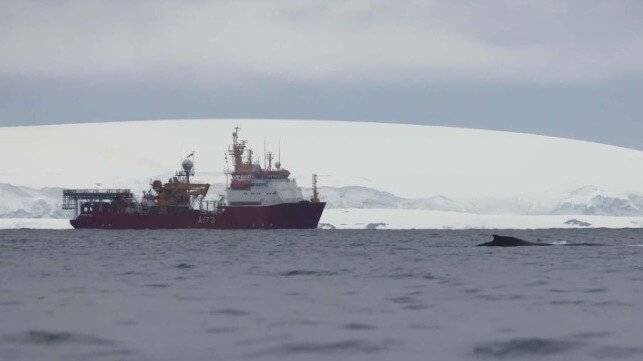Royal Navy Helps Study Tourism's Impact on Antarctica

The Royal Navy took scientists on an Antarctic research mission to analyze the increasing impact of tourism and climate change on the frozen continent.
HMS Protector was joined by two University of Portsmouth researchers who collected water and rock samples as the first phase of the ice breaker’s annual polar mission took her from the Falkland Islands south along the western edge of the Antarctic Peninsula.
The work of the university’s Professor of Environmental Pollution, Fay Couceiro, and Dr Clare Boston, will ultimately contribute to understanding the impact on Antarctica as record numbers of tourists continue to visit the delicate region.
Professor Couceiro collected water samples at the Falkland Islands, Anvers Island, Port Lockroy, Detaille Island and Pourquoi Pas Island and at the Rothera Research Station, Britain’s biggest facility in Antarctica.
Those samples will be tested for concentrations of microplastics, metals and nutrients, providing insight into the impact humans may be having on Antarctica.
Dr Boston, meanwhile, is examining the glacial advances during the last 5,000 years by taking rock samples from Pourquoi Pas Island and, with help from Protector’s hydrographers, collected data in Marguerite Bay to look at landforms created by the Antarctic Peninsula Ice Sheet around 20,000 years ago.
She said: “I’ve had an amazing experience joining HMS Protector, seeing the Antarctic wildlife and collecting data. The crew have worked hard to get me ashore and help me find some rocks.”
On her voyage south, Protector recorded more than 1,000 square miles – an area the size of Dorset – of seabed data in areas that were either uncharted or poorly charted.
This work will increase the safety of seafarers sailing through this region at a time when maritime traffic is significantly increasing – between 2011 and 2020 the number of voyages to Antarctica almost doubled from 234 to 408. The data collected will all be given to the UK Hydrographic Office for inclusion in charts and navigation publications.
The ship also delivered 1.5 tonnes of timber, steel and conservation supplies to Port Lockroy to help the UK Antarctic Heritage Trust (UKAHT) members complete structural works on the roof of the historic building there, protecting it from the elements for years to come.
“I was really looking forward to going ashore for my first time in Antarctica and seeing some of the wildlife,” said Writer Emma Whittingham. “Whilst walking around Port Lockroy, I noticed some penguins with eggs and was delighted when one of them began to hatch right in front of me. What an experience.”
It wasn’t all work and no play in Port Lockroy as the ship’s company became the first from a Royal Navy vessel to paddleboard in Antarctica's waters.
Sailors explored the stunning natural icy waters of the harbour, the shoreline of which is home to a living museum, shop and the most southerly operational Post Office in the world. Curious penguins investigated the paddle boarders, swimming right up to the group to say hello.
Onward Protector went to Detaille Island, where the UKAHT members would stay for several weeks to carry out conversation work on Base W, a former research station of the British Antarctic Survey that was quickly vacated in 1959 after unstable ice around the island cut scientists off from their supply ships.
Three tonnes of stores and supplies were ferried ashore by Protector’s Zodiac boats over 48 hours in arduous conditions. Protector will return to Detaille Island in the second phase of her deployment, before returning the UKAHT team back to the Falkland Islands.
“It was a huge privilege to have the opportunity to collaborate with members of the UK Antarctic Heritage Trust and support their mission in delivering essential building materials and supplies for the conservation of historic buildings around the Antarctic Peninsula. An experience I will never forget,” said Lieutenant Commander Lindsey Gascoigne, Protector’s Logistics Officer.
“The team in Protector have willingly worked extremely hard, often in extreme environmental conditions in terms of freezing temperatures, near gale force winds and of course ice,” said Commander Mark Vartan, Protector’s Executive Officer. “All have put in many long days whether that be feeding hungry mouths, avoiding ice bergs, launching and driving boats or keeping the machinery running without fail, to achieve the mission."
No comments:
Post a Comment